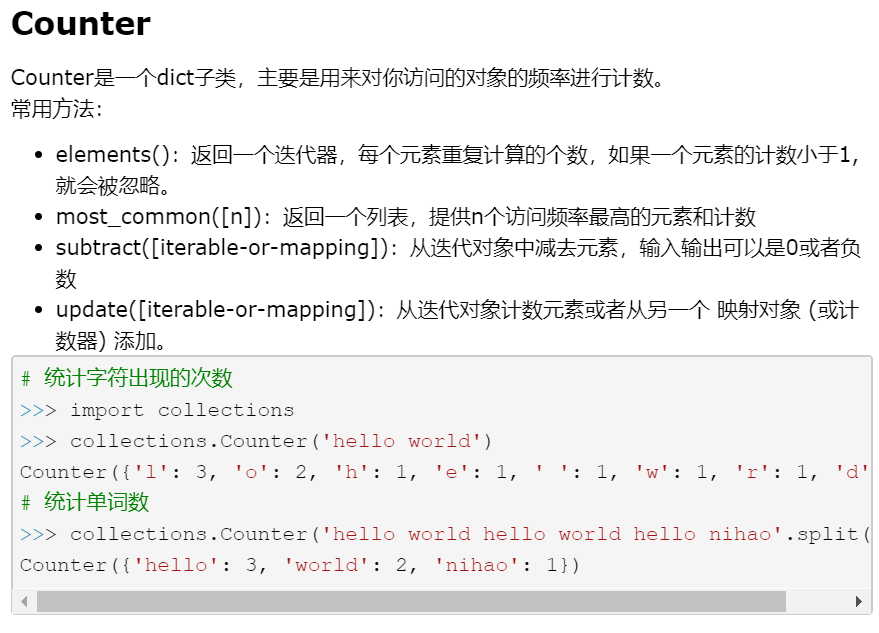描述
数组中有一个数字出现的次数超过数组长度的一半,请找出这个数字。例如输入一个长度为9的数组[1,2,3,2,2,2,5,4,2]。由于数字2在数组中出现了5次,超过数组长度的一半,因此输出2。你可以假设数组是非空的,并且给定的数组总是存在多数元素。1<=数组长度<=50000,0<=数组元素<=10000
讨论组Python有三种解法:
①用Python的标准库Collections
# -*- coding:utf-8 -*-
class Solution:
"""第一种,用python的标准库collections"""
def MoreThanHalfNum_Solution(self, numbers):
# write code here
from collections import Counter
count = Counter(numbers).most_common()
if count[0][1] > len(numbers)/2.0:
return count[0][0]
return 0
关于这个标准库的解释在https://www.cnblogs.com/dianel/p/10787693.html。
 所以Counter可以找到每个元素的个数。
所以Counter可以找到每个元素的个数。
然后因为题目中提到数组中有一个数字出现的次数超过数组长度的一半,所以这个时候使用most_common()函数。
总的来说,most_common()函数就是实现Top_n功能,也就是从高到低排序。
def most_common(self, n=None):
'''List the n most common elements and their counts from the most
common to the least. If n is None, then list all element counts.
>>> Counter('abcdeabcdabcaba').most_common(3)
[('a', 5), ('b', 4), ('c', 3)]
'''
# Emulate Bag.sortedByCount from Smalltalk
if n is None:
return sorted(self.items(), key=_itemgetter(1), reverse=True)
return _heapq.nlargest(n, self.items(), key=_itemgetter(1))该段代码引用来源于博客https://blog.csdn.net/zyx_ly/article/details/88202672。
例如:输入[1,2,3,2,2,2,5,4,2]
count的输出为:[(2, 5), (1, 1), (3, 1), (5, 1), (4, 1)]
即元素加元素的个数。
所以此时,count[0][1]就是出现次数最大的次数,count[0][0]就是出现次数最大的那个数。
②第二种假设有这个数字,那么它的数量一定比其它所有数字之和还要多,按照这个思路得出num,然后验证。
因为这个数出现的次数是整个数组的一半还要多,比如说输入[1,2,3,2,2,2,5,4,2],
此时num=numbers[0]=1,当i=1时,numbers[1]为2,所以count-1=0,这时候num置换到下一位numbers[1]=2的身上,count重新设置为1,
因为i的循环是从1开始,所以一开始的if语句判断正确,count+=2,然后-1,+1,+1,+1,-1,-1,+1,然后发现数字2就是这一个数组里面出现次数最多的数(因为别如果换成3的话,count又会变成0,置换到下一位),那么接下来的工作就是看这个次数是不是大于这个数组的一半长度了。所以最后几行代码,就是遍历整个数组,累加出现次数,如果大于则输出数字2。
class Solution:
"""第二种,假设有这个数字,那么它的数量一定比其它所有数字之和还要多,按照这个思路得出num,然后验证
"""
def MoreThanHalfNum_Solution(self, numbers):
# write code here
if not numbers:
return 0
num = numbers[0]
count = 1
for i in range(1, len(numbers)):
if numbers[i] == num:
count += 1
else:
count -= 1
if count == 0:
num = numbers[i]
count = 1
count = 0
for i in numbers:
if i == num:
count += 1
return num if count > len(numbers) / 2.0 else 0
③ 第三种对列表排序,计算下标为len/2(即中间位置)的数字数量
主要排序工作多一些。
class Solution:
"""对列表排序,计算下标为len/2(即中间位置)的数字数量即可"""
def MoreThanHalfNum_Solution(self, numbers):
# write code here
# 对列表进行快排
left = 0
right = len(numbers) - 1
stack = [right, left]
while stack:
low = stack.pop()
high = stack.pop()
if low >= high:
continue
less = low - 1
mid = numbers[high]
for i in range(low, high):
if numbers[i] <= mid:
less += 1
numbers[less], numbers[i] = numbers[i], numbers[less]
numbers[less + 1], numbers[high] = numbers[high], numbers[less + 1]
stack.extend([high, less+2, less, low])
# 验证
count = 0
length = len(numbers) // 2
for i in numbers:
if i == numbers[length // 2]:
count += 1
return numbers[length // 2] if count > length / 2.0 else 0④有一个C/C++代码很简洁,可以了解下:
class Solution {
public:
int MoreThanHalfNum_Solution(vector<int> numbers) {
int n = numbers.size();
//map 记录出现次数
map<int, int> m;
int count;
for (int i = 0; i < n; i++) {
count = ++m[numbers[i]];
if (count > n/2) return numbers[i];
}
return 0;
}
};最后
以上就是奋斗饼干最近收集整理的关于JZ28 数组中出现次数超过一半的数字的全部内容,更多相关JZ28内容请搜索靠谱客的其他文章。








发表评论 取消回复